
Scientists have announced that they have created the first successful human-animal hybrids.
Their controversial project proves that human cells can be introduced into a non-human organism, survive, and even grow inside a host animal, in this instant, pigs.

BYPASS THE CENSORS
Sign up to get unfiltered news delivered straight to your inbox.
You can unsubscribe any time. By subscribing you agree to our Terms of Use
Latest Video
The scientists say they hope the chimera embryos represent key steps toward life-saving lab-grown organs.
What could possibly go wrong?
Global Research reports: This biomedical advance has long been a dream and a quandary for scientists hoping to address a critical shortage of donor organs.
What if, rather than relying on a generous donor, you could grow a custom organ inside an animal instead?
That’s now one step closer to reality, an international team of researchers led by the Salk Institute reports in the journal Cell. The team created what’s known scientifically as a chimera: an organism that contains cells from two different species.
In the past, human-animal chimeras have been beyond reach. Such experiments are currently ineligible for public funding in the United States (so far, the Salk team has relied on private donors for the chimera project). Public opinion, too, has hampered the creation of organisms that are part human, part animal.
But for lead study author Jun Wu of the Salk Institute, we need only look to mythical chimeras—like the human-bird hybrids we know as angels—for a different perspective.
“In ancient civilisations, chimeras were associated with God,” he says, and our ancestors thought “the chimeric form can guard humans.” In a sense, that’s what the team hopes human-animal hybrids will one day do.
Building a Chimera
There are two ways to make a chimera. The first is to introduce the organs of one animal into another—a risky proposition, because the host’s immune system may cause the organ to be rejected.
The other method is to begin at the embryonic level, introducing one animal’s cells into the embryo of another and letting them grow together into a hybrid.
It sounds weird, but it’s an ingenious way to eventually solve a number of vexing biological problems with lab-grown organs.
When scientists discovered stem cells, the master cells that can produce any kind of body tissue, they seemed to contain infinite scientific promise. But convincing those cells to grow into the right kinds of tissues and organs is difficult.
Cells must survive in Petri dishes. Scientists have to use scaffolds to make sure the organs grow into the right shapes. And often, patients must undergo painful and invasive procedures to harvest the tissues needed to kick off the process.
At first, Juan Carlos Ispizua Belmonte, a professor in the Salk Institute’s Gene Expression Laboratory, thought the concept of using a host embryo to grow organs seemed straightforward enough. However, it took Ispizua and more than 40 collaborators four years to figure out how to make a human-animal chimera.



